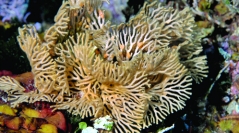

 Zoosystema
42 (27) - Pages 525-545
Zoosystema
42 (27) - Pages 525-545Hornera Lamouroux, 1821, a genus which includes large, rigidly erect, ramified and highly calcified cancellate cyclostome species, is represented in the Mediterranean Sea by two species, H. frondiculata (Lamarck, 1816), the type species of the genus, and a species previously left unnamed or wrongly attributed to the northern H. lichenoides (Linnæus, 1758), and classed under this name as threatened in the Mediterranean (Barcelona Convention, Annex II). On the basis of abundant material including large, well-preserved colonies collected by diving, the distinctive morphological and ecological features of these two species are detailed, leading to the description of a new species, H. mediterranea n. sp., and to a better characterization of H. frondiculata. The current state of knowledge of the range of the two Hornera species suggests that they are endemic to the Mediterranean. Their depth and habitat distributions span from 30 to 100 m on both dimly lit rocky walls and flat bottoms with coarse elements for H. frondiculata, and from 55 to 200 m only on flat sandy bottoms for H. mediterranea n. sp., but both species can coexist in the same microhabitat. The distribution of H. frondiculata in two separate habitats is reflected in a remarkable plasticity of colony shape and branching design which optimizes food particle capture according to local flow conditions.
cyclostomes, biogeography, habitat distribution, colony shape, reproduction strategy, SPA-BD protocol annex II, new species